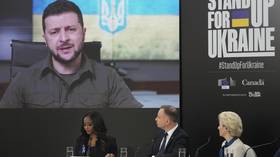UN inspectors visit Ukrainian nuclear sites

International Atomic Energy Agency (IAEA) inspectors have begun “verification activities” at two locations in Ukraine, the UN body announced on Monday. Russia has accused Kiev of using the sites to produce a ‘dirty bomb’, which would then be detonated to frame Moscow and draw NATO forces into the conflict.
The inspectors’ work will be completed soon, and IAEA Director General Rafael Grossi will present his initial conclusions later this week, the UN organization stated in a press release.
While the IAEA said that the inspections were performed at the request of the Ukrainian government, Russia initially singled out the two facilities – the Institute for Nuclear Research in Kiev and the Vostochny Mining and Processing Plant in Dnipropetrovsk Region – as locations where Ukraine was allegedly preparing a radioactive ‘dirty bomb’.
In a letter to the UN Security Council last week, Russian envoy Vassily Nebenzia said that staff at these locations “have received direct orders from [Ukrainian President Vladimir] Zelensky’s regime to develop such a dirty bomb,” and that plans to create such a device were “at their concluding stage.”
The IAEA announced last Thursday that it would investigate these claims, which have been denied by Kiev and dismissed by Western leaders.
Russian Defense Minister Sergey Shoigu phoned his counterparts in the US, UK, France, Türkiye, India, and China last week to warn them of a possible provocation by Ukraine. Meanwhile, Russian President Vladimir Putin also referenced the two nuclear facilities in a lengthy speech, adding that he believed Kiev was attempting to cover its tracks ahead of the IAEA’s visit.
A ‘dirty bomb’ is not a nuclear bomb in the traditional sense. Rather, it uses conventional explosives to scatter radioactive material over a wide area.
Ukrainian Foreign Minister Dmitry Kuleba described Russia’s allegations last week as “absurd,” suggesting that Moscow may harbor its own plans to detonate such a device. Russia has repeatedly stated that it will not use nuclear weapons in Ukraine, and the US intelligence community has acknowledged that there is no evidence it plans to.
The IAEA said that it had investigated one of the nuclear sites a month ago and found “no undeclared nuclear activities or materials” there. However, Nebenzia cautioned Grossi to “be vigilant,” as the two locations are not the only ones where a dirty bomb could be built.














